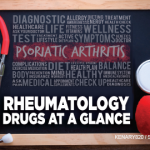
kenary820 / shutterstock.com
CHICAGO—As Eric Ruderman, MD, professor of medicine in rheumatology at Northwestern University Feinberg School of Medicine in Chicago, began his talk on psoriatic arthritis treatment at the ACR State-of-the-Art Clinical Symposium in April, he marveled a bit at how much there was to cover. Drugs gaining prominence in the treatment of rheumatoid arthritis and dermatological diseases have begun to carry over into psoriatic arthritis (PsA) research, where many have proved effective.
“Just a year ago, this talk would have had a lot less involved,” he said.
Biologics are being assessed in PsA at a rapid rate—some with persuasive data, some in small but tantalizing samples, Dr. Ruderman said. As new therapies undergo testing, he said, it’s important to consider how they affect the array of disease manifestations.
“This is not just about joints,” he said. “This is a disease that’s about joints, it’s about skin, it’s about enthesitis, it’s about dactylitis, it’s about nail disease. So many other pieces.”
Dr. Ruderman spoke about several therapies, including apremilast, tofacitinib, abatacept, ustekinumab, ixekizumab, secukinumab, bimekizumab, risankizumab and guselkumab.
Apremilast
This drug—which targets cyclic adenosine monophosphate (cAMP), a regulator of several key immune pathways—works for enthesitis and dactylitis, “[a]nd the drug works quickly. We’re used to that with these targeted small molecules,” Dr. Ruderman said. Effects were seen within two to four weeks.1
He advised clinicians not to misinterpret the drug’s ACR 20% score (ACR20) response rate of 40%. “One thinks, ‘Well, that’s not so good.’… Be careful about assuming that means this drug works less well in the people in whom it works. I think what it really means is, this drug works in fewer people. … The people who respond, some of them actually respond pretty well.”
Importantly, he said, “you’re not seeing the immunosuppressive effects [with apremilast] that raise concern for infections [that] we see with some of the biologic agents we’ve been concerned about.”
More data are needed to sort through what can be confusing options, Dr. Ruderman said. ‘We need good comparative efficacy studies.’
Tofacitinib
This JAK1 and JAK3 inhibitor has been the subject of two PsA trials in the last year, and it was recently approved for PsA. “The tofacitinib response was in the same order of magnitude as we’re used to seeing with adalimumab” among inadequate responders to conventional disease-modifying anti-rheumatic drugs (DMARDs), he said.2
Abatacept
This therapy, which binds CD80 and CD86, produced a “modest” ACR20 response rate of 40%, but it was still superior to placebo and is another option for patients who fail earlier treatments. The response on skin was not impressive, Dr. Ruderman said.
Regarding drugs acting through new pathways, Dr. Ruderman said these have been “the most exciting thing in this space.”
Ustekinumab
The monoclonal antibody ustekinumab, targeting the pb40 subunit present in both IL12 and IL23, produced good ACR responses, with a “decent” skin response, he said. In this instance, the key target is IL23.3
“The advantage to this drug for skin disease is you give it every three months, so it’s a really convenient drug,” he said. It also showed radiographic benefit.
Ixekizumab & Secukinumab
Both of these IL17 inhibitors produce highly impressive results in skin, with 80–90% improvement in some cases, Dr. Ruderman said. They also have been found to work in enthesitis and dactylitis.
For secukinumab, Dr. Ruderman said, “Patients who have been on a TNF [inhibitor] are a bit less likely to respond to the 150 mg dose than the 300 mg dose. Both doses are approved for the treatment of psoriatic arthritis, but probably the higher dose is going to be the more appropriate dose in that population of patients.”
The trial, presented recently at the 2017 ACR/ARHP Annual Meeting in November, was the first with this agent to show radiographic improvement in patients who hadn’t received IV loading first, he said.
On the Horizon
Drugs that are even newer, but not as far down the road toward approval, include bimekizumab, which targets both IL17A and IL17F to yield deeper inhibition, and the IL23 inhibitors risankizumab and guselkumab.
With all these new therapies, more data are needed to sort through what can be confusing options, Dr. Ruderman said. “We need good comparative efficacy studies. We’re beginning to get that in rheumatoid arthritis. We’re behind the eight ball here. We need that for sure. We’ve got good drugs. … We need to know how to use them.”
Thomas R. Collins is a freelance writer living in South Florida.
References
- Nash P, Ohson K, Walsh J, et al. Early and sustained efficacy with apremilast monotherapy in biological-naïve patients with psoriatic arthritis: A phase IIIB, randomised controlled trial (ACTIVE). Ann Rheum Dis. 2018 May;77(5):690–698.
- Mease P, Hall S, FitzGerald O, et al. Tofacitinib or adalimumab versus placebo for psoriatic arthritis. N Engl J Med. 2017 Oct 19;377(16):1537–1550.
- Ritchlin C, Rahman P, Kavanaugh A, et al. Efficacy and safety of the anti-IL-12/23 p40 monoclonal antibody, ustekinumab, in patients with active psoriatic arthritis despite conventional non-biological and biological anti-tumour necrosis factor therapy: 6-month and 1-year results of the phase 3, multicentre, double-blind, placebo-controlled, randomised PSUMMIT 2 trial. Ann Rheum Dis. 2014 Jun;73(6):990–999.


